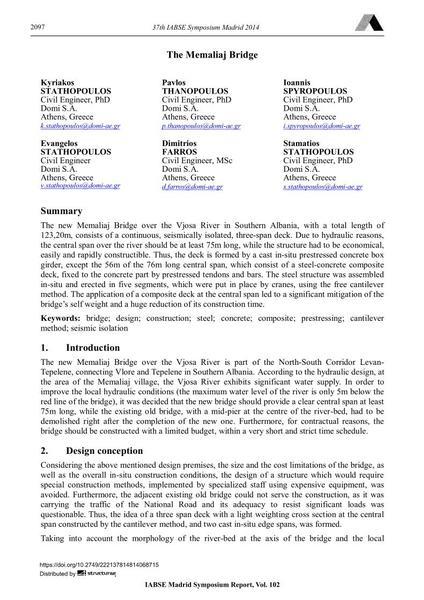The Memaliaj Bridge

|
|
|||||||||||
Bibliographic Details
| Author(s): |
Kyriakos Stathopoulos
Pavlos Thanopoulos Ioannis Spyropoulos Evangelos Stathopoulos Dimitrios Farros Stamatios Stathopoulos |
||||
|---|---|---|---|---|---|
| Medium: | conference paper | ||||
| Language(s): | English | ||||
| Conference: | IABSE Symposium: Engineering for Progress, Nature and People, Madrid, Spain, 3-5 September 2014 | ||||
| Published in: | IABSE Symposium Madrid 2014 | ||||
|
|||||
| Page(s): | 2097-2104 | ||||
| Total no. of pages: | 8 | ||||
| Year: | 2014 | ||||
| DOI: | 10.2749/222137814814068715 | ||||
| Abstract: |
The new Memaliaj Bridge over the Vjosa River in Southern Albania, with a total length of 123,20m, consists of a continuous, seismically isolated, three-span deck. Due to hydraulic reasons, the central span over the river should be at least 75m long, while the structure had to be economical, easily and rapidly constructible. Thus, the deck is formed by a cast in-situ prestressed concrete box girder, except the 56m of the 76m long central span, which consist of a steel-concrete composite deck, fixed to the concrete part by prestressed tendons and bars. The steel structure was assembled in-situ and erected in five segments, which were put in place by cranes, using the free cantilever method. The application of a composite deck at the central span led to a significant mitigation of the bridge’s self weight and a huge reduction of its construction time. |
||||
| Keywords: |
steel design concrete bridge seismic isolation composite construction prestressing cantilever method
|
||||
